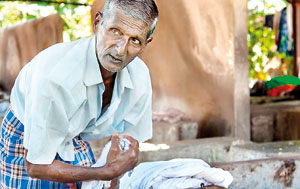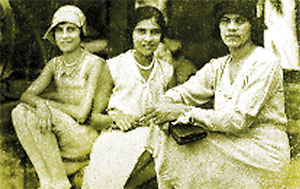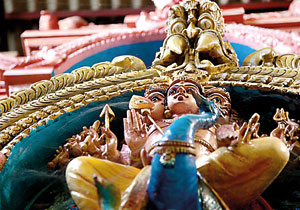At www.movingimages.asia, Sharni Jayawardena and Tarika Wickremeratne take a walk about Slave Island, Kannan Arunasalam films ‘portraits of resilience’ in Jaffna and Menika van der Poorten searches out what’s left of the planter Eurasian community. Employing photography and film, the series is modelled on one that ran in the New York Times - the Emmy award winning ‘One in Eight Million’.
Though styles and subjects vary greatly they are united in the intimacy of their portrayals, in their focus on otherwise hidden lives and finally in their decision to have each tale narrated in the voice of their subjects. With their beautiful images and choice of theme, the projects combine artistry with serious documentary work.
 |
| One of the residents featured in ‘Walkabout: Slave Island’ |
 |
| The three sisters portrayed in ‘A Lost White Tribe: The Eurasians of Sri Lanka’ |
 |
| Inspiration from Jaffna |
“It was a way to express creativity but also to record things,” says Sharni, whose project was titled ‘Walkabout: Slave Island’. Working with Tarika, also a photographer, Sharni says she wanted to capture the chaos and colour of the area through the personalities of 12 of its residents.
So it is that we are introduced to Dolly achchi, one of the area’s oldest, most feisty female citizens and to Munisekar who has served as a priest in the Sivasubramaniam Kovil for nearly 33 years.
Many of the subjects chosen belong to the older generation, says Sharni, explaining that it often felt like they simply had more interesting stories to tell. Nevertheless, young adults such as Fathima Suleika are also portrayed as key storytellers in this time of transition.
Plans are already underway to demolish parts of Slave Island, say Sharni and Tarika, noting in their introduction that the personal stories that form the set ‘will hint at the complexity of living in such a locality – where cultures clash with security concerns; where industry coexists with poverty; where age-old traditions come to grips with newer trades.’ Sharni believes there is a driving need to document these vanishing worlds. “Every day we lose a voice,” she says, explaining that the decision to use their subject’s own voices to narrate the story was simply another layer of documentation. (Each documentary is made up of a series of images that follow each other like a slide show.)
The two women used sound in other ways as well. The distant clack of a train, the gush of a running faucet, a radio or a noisy group of playing children are used as a creative soundtrack to the images and these bring a sense of movement and continuity across each set of photographs. The semi-continuous hum of voices and machines in the background also hint at one of the area’s defining characteristics – what Sharni identifies as a strong sense of community. “They just get along with each other,” she says, remembering that the residents were to be found out on the street at all hours, exchanging gossip and playful insults. “The boys from the Java Lane would play football with the boys from Glennie Street,” she says, adding that the place is still very vibrant and very colourful.
So much so, that Sharni says that preserving at least parts of it is something the tourism industry should consider. The two artists elaborate on both the history of Slave Island and the trials its residents face in some detail in the introduction to ‘Walkabout’.
Kannan Arunasalam, who was also awarded a grant, is the only one to choose film as his medium. The images are in glorious HD, and three films look for inspiration to Jaffna in the war years. In the first ‘Kerosene: How does a taxi driver take the sick to the hospital when there’s no fuel around?’ Kannan speaks with the owner of small garage and with local taxi drivers. Petrol and diesel were on the list of restricted items during the embargo imposed by the government on LTTE controlled areas, but Jaffna’s taxi drivers found creative ways to keep their cars running. During the embargo’s peak in the 90s, “We got used to driving without batteries, we got used to driving without lights,” says one man. His is a garage filled with old English cars, bought for cheap because there was no petrol to run them with. They would make their own spare parts and run the cars on kerosene. When the kerosene ran out they turned to a mix of vegetable oil and engine oil. When that ran out, it was on to sesame oil.
Another restricted item was newsprint, and Kannan shares the story of the publishers’ of the newspaper Uthayan’s desperate hunt for newsprint. They made do with whatever they could coax out of local merchants – even ruled notebook paper. Braving violence to themselves, censorship and deprivation, they kept going. ‘Paper: The incredible story of Uthayan in Jaffna’ begins with a telling quote - “Our aim is not to starve the people of news...because a newspaper is one of the essential, emergency items for a man,” says one man.
‘How does a community with leprosy survive despair and isolation?’ asks Kannan in the preamble to his third piece. ‘Koothu: Theatre and leprosy in Jaffna’ uploaded last month, is the last of the set. It tells the tale of the spread of leprosy among the villagers of the coastal village of Katupulam through the eyes of Dr. Sivarajah, who led the team that first discovered the outbreak. It also showcases a form of street theatre known as Koothu that was taken up by the younger members of the community. The words spoken by young voices on the film are particularly moving.
While all three are well worth watching, be warned that downloading the movies requires a great deal of patience for those with slower connections. More of Kannan’s work can also be seen on http://iam.lk/ a compilation of voices from across the island.
Menika too goes in search of disappearing voices. Her choice of medium for ‘A Lost White Tribe: The Eurasians of Sri Lanka’ though is black and white photography. Her focus is also narrower. Hers is a very personal quest, a matter of family. Her great-grandfather was a third generation Englishman living in Sri Lanka, and he and his brother were the first to look among the locals for a wife. “The whole story of the Eurasians is quite close to me because of my memories of my grandmother, her sisters and brothers (11 of them) and all their kids,” says Menika. She remembers that most of them were “pretty wild” and adds, “That’s what really attracted me to them.” The videos on www.movingimages.asia feature Eurasians from outside Menika’s family as well, and she says she’s received many emails from people all over the world who feel they can relate. “They’re happy to have their identity validated,” observes Menika, explaining that many left their homes in the wake of the Sinhala only policy.
Of the small group that remained most are to be found in Kandy and occasionally in Colombo and it took Menika a combination of luck and diligence to track them down. Introducing herself, she found that her name went a long way. Many of her subsequent conversations were laced with nostalgia for a lost way of life. Today, “most of them feel that they don’t belong here, that they got left behind,” says Menika.
Among those who migrated, Menika sometimes sees “a huge well of feeling.” “A lot of them still think of Sri Lanka,” she says, “This is home, still.”
Moving Images was commissioned by Groundviews and supported by grants from the Ford Foundation.
(Images courtesy Menika van der Poorten, Sharni Jayawardena and Tarika Wickremeratne and Kannan Arunasalam) |
